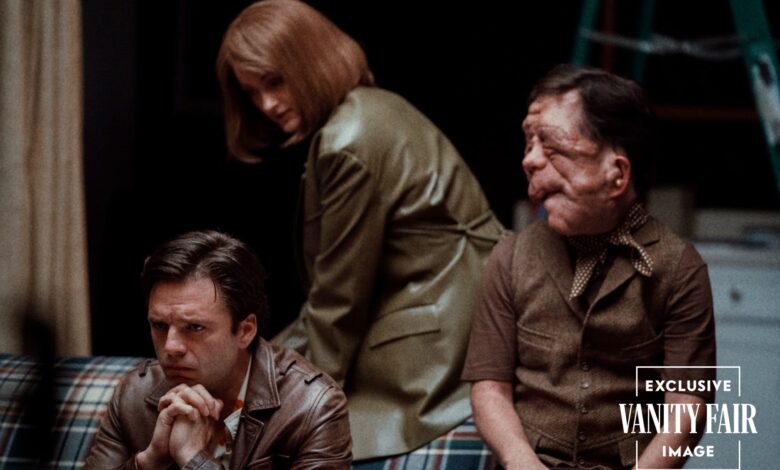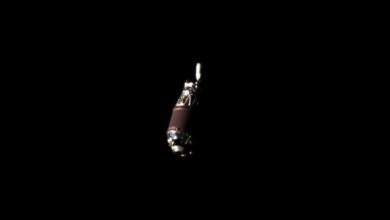Sebastian Stan Confronts an Actor’s Worst Nightmare in A24’s Sundance Hit ‘A Different Man’

When making an indie, you do what you can when you can—there’s not enough money or time for a flexible alternative. For Sebastian Stan during production in New York on A Different Man, A24’s trippy dark comedy, this meant, at times, getting into the makeup chair at 5:00am, before prosthetics designer Michael Marino had to run to his other job on The Marvelous Mrs. Maisel. By the time they were finished—with Stan, portraying a man named Edward who lives with an acute facial disfigurement, completely transformed—the actor still had a few hours to kill. He’d use that time to venture into the world. He’d go to his favorite coffee shop and, to put it mildly, no one would recognize him. “You’d see the reaction immediately, and then they suddenly feel compelled to be three times as nice,” Stan says. “You feel this shift.”
This was a useful way to get into the headspace of how someone like Edward moves through the world. But that’s only the starting point of A Different Man, which writer-director Aaron Schimberg (Chained for Life) fashions into a dizzying meta-commentary on exactly Stan’s experience, as a handsome actor playing a disfigured loner. “I was born with a cleft palate and I view the world through that lens—and it’s a precarious position because a film’s commercial viability is dependent in large part on stars, and we don’t have stars with facial disfigurements,” Schimberg says “Then if you cast people with facial disfigurements, which is what I’ve historically done, besides the risk of marginalizing the film some people may call that out as inherently exploitative, which seems to run counter to the whole conversation about representation.” He takes a breath, clearly having struggled with coming to terms with this no-win situation: “This is a subject most people just want to avoid.”
A Different Man confronts that fact. We meet Stan’s Edward, an aspiring actor, in full prosthetics, with Schimberg’s vision approaching grimy ‘70s noir, filming him in ominous tones and echoing the kinds of movies that wallow in a disabled person’s sad, lonely life. One bright spot is an unexpected bond Edward strikes up with his playwright neighbor, Ingrid (Renate Reinsve); it’s just as unexpectedly cut off, though, when he goes through with an elaborate reconstruction surgery that has him looking like, well, Sebastian Stan. The film’s aesthetic shifts to a stylized modern New York comedy here, sparked by the unexpected reunion of Ingrid and Edward, whom she does not recognize, after he crashes auditions for a play she’s written—a patronizing, simplistic fictionalization of her time with Edward that traffics in the same stereotypes the film had been, until that point, carefully sending up. Of course, Edward auditions and nabs the part—left to wear a mask of the man he left behind.
It’s layered, thorny stuff, with Stan bringing a biting sense of humor and internal intensity to a part that’s hard to pin down. “I’ve voiced to my agents really specifically what I’ve been wanting to do more of, and I’ve learned enough now where I know where I can be better,” the actor says. “Things like this just never really come my way.” Of what resonated with him in the material, he adds, “We’re haunted constantly by these ideas about life and what we want our life to be—and so, often what we sacrifice are the things that set us apart, identity and things that we can claim as ourselves, even if that includes difficult experiences.”
Schimberg’s previous films have explored similar themes, though on a far smaller scale; he’d challenged himself with A Different Man to go bigger, to “use New York City,” but wasn’t getting anywhere funding-wise until Stan signed on board—which he did rather quickly upon receiving the script. “Within seven weeks, we were shooting the film,” he says.
But Edward was only one half of the initial conceit for A Different Man. When Schimberg was thinking about the representational impossibilities of disfigured actors, he went back to the scene-stealer of his previous film, Adam Pearson. He wanted to cast him again, and let him show his range opposite a typical Hollywood star. I thought, ‘Okay. I’m going to try it both ways,” Schimberg says “I’m going to cast a Hollywood actor in prosthetics and an actor with a facial disfigurement—and it will be a battle between them.”
In Chained for Life, viewers assumed Adam Pearson was playing a version of himself. “In the movie, he’s this quiet shy person—and Adam isn’t like that at all,” Schimberg says. “He’s extremely gregarious and extroverted. The character he was playing was based more on my own personality.” A Different Man allows Pearson to step into the kind of charming, clever, approachable, character rarely if ever offered to actors with disfigurements, but closely resembling his own way of moving through the world. “I really liked that Oswald’s disability is rarely mentioned, if at all—he is just a guy who’s decent and good at his job,” Pearson tells me. “And Oswald’s disability in the film is the least interesting thing about him, just like in real life, my disability is the least interesting thing about me.”
Pearson comes in as Oswald, a friendly neighbor who walks in on a rehearsal of Edward performing Ingrid’s play. Not aware of Edward’s past—how could he be—Oswald suggests coming aboard the production as a consultant on living with a disfigurement. Ingrid happily obliges, then gets closer to him, then starts adjusting the play to reflect the experience of disfigurement with more nuance and empathy. In all this, Edward gets further and further away from a play based on his very life—the joke is very much on him, with Oswald’s oblivious kindness slowly turning A Different Man into a tragicomic portrait of inauthenticity. “The way we judge others is a reflection or manifestation of the way we feel about ourselves,” Schimberg says. “The viewer identifies with Edward, knowing that Edward is looking at Oswald and feeling things about himself relating Oswald to himself…. It started as a Jekyll and Hyde story and morphed into this other thing, little by little.”
Stan connected to the dynamic in his own way: “Aaron was able to capture between this nebulous bridge that sometimes happens between reality and acting.”
The narrative twist here finds Pearson almost acting as the straight man, with Edward gradually breaking down as his dream is crushed, cruelly but inevitably, by the part of himself that he’d erased. This was a new kind of part for Pearson, who made his screen debut a decade ago in Jonathan Glazer’s Under the Skin and since then has attempted to build a filmography as best he could. “You tend to get offered the tropes of disability and disfigurement—you either have the false hero, the victim, or the villain—and a character’s disability is the raison d’etre for what they do,” he says. “The idea that, because I have a disfigurement, I want to burn and drop into the ground, or I live under a volcano and I’m just waiting for the demise of 007, so I can finally get on with world domination.” Pearson pauses. “It’s all very one note.”
This has something to do with social conditioning, too. On one of Stan’s early days in prosthetic makeup, when he went out into the world, he sat outside, minding his own business. A little girl, maybe five or six, started staring at him and kept staring. She wasn’t judging, or horrified; she appeared curious, inquisitive. Finally, she ran up to Stan and asked matter-of-factly, “What’s wrong with you?” Before he could answer, though, the girl’s mother rushed up to them, profusely apologized, and took her away. “It encapsulated a little bit of some of what the movie is talking about, right—you have a young person simply curious to understand what’s going on and the parent is there trying to defuse the situation in a way that’s a learned behavior, that’s now being passed on,” Stan says. “It made me think a lot.”
For Pearson, he hopes A Different Man has a similar impact. “Who are we on the outside versus who we are on the inside, and what happens when those two things don’t necessarily run together?” the actor says. “Some of the greatest films change how people think about something. And Aaron Schimberg is in the business of great films.”
To celebrate Sundance’s 40th anniversary, Awards Insider is publishing exclusive previews of some of this year’s festival’s most exciting premieres. See more here.
Listen to Vanity Fair’s Little Gold Men podcast now.
-
Simone Biles Talks Marriage, WAG Life, and the Paris Olympics
-
Cary Grant and Randolph Scott’s True Hollywood Story
-
A Legendary Photographer Recounts Storming America With the Beatles
-
The Wild Truth Behind a So-Called Real Gone Girl Case



